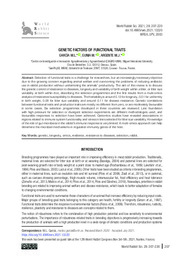Por favor, use este identificador para citar o enlazar este ítem:
https://hdl.handle.net/11000/35718Registro completo de metadatos
| Campo DC | Valor | Lengua/Idioma |
|---|---|---|
| dc.contributor.author | Garcia Pardo, Maria Luz | - |
| dc.contributor.author | Gunia, Mélanie | - |
| dc.contributor.author | Argente, María José | - |
| dc.contributor.other | Departamentos de la UMH::Tecnología Agroalimentaria | es_ES |
| dc.date.accessioned | 2025-02-24T12:22:38Z | - |
| dc.date.available | 2025-02-24T12:22:38Z | - |
| dc.date.created | 2021-07 | - |
| dc.identifier.citation | World Rabbit Sci. 29: 207-220 | es_ES |
| dc.identifier.issn | 1989-8886 | - |
| dc.identifier.issn | 1257-5011 | - |
| dc.identifier.uri | https://hdl.handle.net/11000/35718 | - |
| dc.description.abstract | Selection of functional traits is a challenge for researchers, but an increasingly necessary objective due to the growing concern regarding animal welfare and overcoming the problems of reducing antibiotic use in rabbit production without undermining the animals’ productivity. The aim of this review is to discuss the genetic control of resistance to diseases, longevity and variability of birth weight within a litter, or litter size variability at birth within doe, describing the selection programmes and the first results from a multi-omics analysis of resistance/susceptibility to diseases. The heritability is around 0.13 for longevity, 0.01 for uniformity in birth weight, 0.09 for litter size variability and around 0.11 for disease resistance. Genetic correlations between functional traits and production traits are mostly no different from zero, or are moderately favourable in some cases. Six selection programmes developed in three countries are reviewed. Line foundation with high pressure for selection or divergent selection experiments are different methodologies used, and favourable responses to selection have been achieved. Genomics studies have revealed associations in regions related to immune system functionality and stress in lines selected for litter size variability. Knowledge of the role of gut microbiota in the rabbit’s immune response is very limited. A multi-omics approach can help determine the microbial mechanisms in regulation immunity genes of the host. | es_ES |
| dc.format | application/pdf | es_ES |
| dc.format.extent | 14 | es_ES |
| dc.language.iso | eng | es_ES |
| dc.publisher | Universidad Politécnica de Valencia | es_ES |
| dc.rights | info:eu-repo/semantics/openAccess | es_ES |
| dc.rights | Attribution-NonCommercial-NoDerivatives 4.0 Internacional | * |
| dc.rights.uri | http://creativecommons.org/licenses/by-nc-nd/4.0/ | * |
| dc.subject | genetic | es_ES |
| dc.subject | longevity | es_ES |
| dc.subject | omics | es_ES |
| dc.subject | resilience | es_ES |
| dc.subject | resistance to diseases | es_ES |
| dc.subject | selection | es_ES |
| dc.subject | rabbit | es_ES |
| dc.title | Genetic factors of functional traits | es_ES |
| dc.type | info:eu-repo/semantics/article | es_ES |
| dc.relation.publisherversion | https://doi.org/10.4995/wrs.2021.13320 | es_ES |

Ver/Abrir:
colarma,+wrs_29-4_13320.pdf
272,58 kB
Adobe PDF
Compartir:
 La licencia se describe como: Atribución-NonComercial-NoDerivada 4.0 Internacional.
La licencia se describe como: Atribución-NonComercial-NoDerivada 4.0 Internacional.
.png)